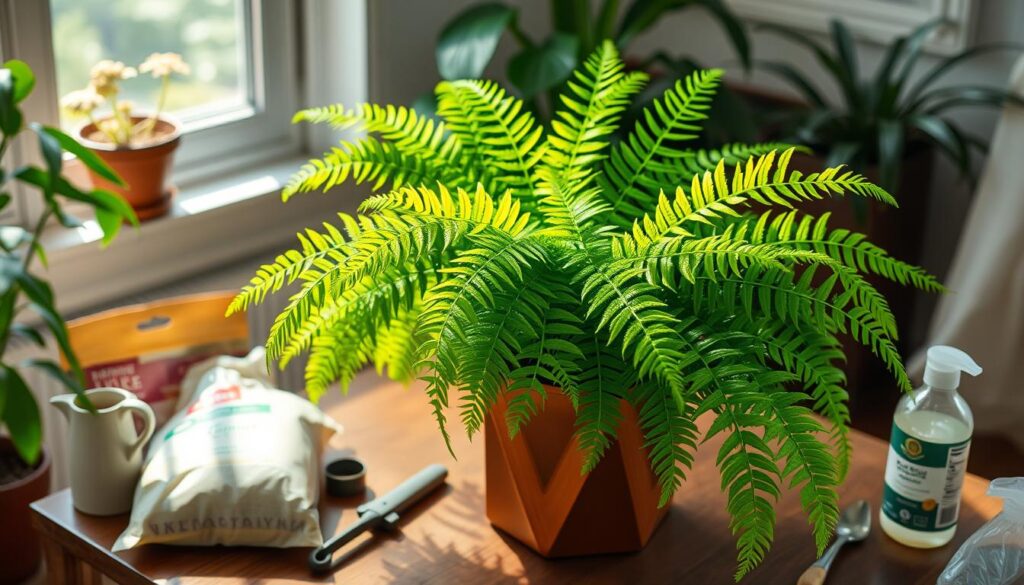Thinking about getting a Boston fern? You might wonder how to take care of it. With the right care, your Boston fern will be stunning. They love bright, indirect light and lots of water.
Boston ferns can grow really tall and have big fronds. They need the right light and water to grow well. Learning how to care for them is important.
We’ll talk about the basics of Boston Fern care. This includes light, water, soil, and fertilizing. Follow these tips to become a Boston fern expert. With good care, your fern will be happy and green for a long time.
Understanding the Boston Fern
Boston Ferns are popular houseplants. They have lush, green fronds and clean the air. To care for your Boston Fern well, you need to know its needs.
Boston Ferns come from tropical places. They love high humidity and bright, indirect light. This makes them perfect for rooms with east- or west-facing windows. For more tips on caring for indoor ferns, check out indoor fern care guides.
It’s important to keep the moisture level right when watering your Boston Fern. Too much water can cause root rot. Too little water can make the fronds turn brown. Also, direct sunlight can burn the fronds. So, give your Boston Fern the right light and water to keep it healthy.
Boston Ferns have feathery fronds and can grow up to 7 feet tall outside. But, indoors, they usually grow 2-3 feet tall. Knowing what your Boston Fern needs helps you care for it well. This way, you can enjoy its beauty for many years.
The Ideal Environment for Boston Fern
To make your Boston Fern happy, you need to know what it likes. It loves bright, indirect light and lots of moisture. This makes it perfect for places that are really humid. When you repot Boston Ferns, keep the humidity high, over 80 percent. This stops leaves from falling and helps it grow well.
Boston Ferns do best in temperatures between 60 to 75 degrees Fahrenheit. Also, pruning Boston Ferns often helps them look good and grow strong. Here are some important things to think about for your Boston Fern’s home:
- Ideal humidity level: above 80 percent
- Optimal indoor temperature range: 60 to 75 degrees Fahrenheit
- Recommended soil pH: 5 to 5.5
Give your Boston Fern the right home, and it will do great. Make sure to water it often. Change how often you water based on how you planted it. With good care, your Boston Fern can grow big, up to 3 feet tall and wide. It will be a lovely addition to any room.
| Factor | Recommended Level |
|---|---|
| Humidity | Above 80 percent |
| Temperature | 60 to 75 degrees Fahrenheit |
| Soil pH | 5 to 5.5 |
Watering Your Boston Fern
Watering your Boston Fern right is key for its health and growth. Knowing when it’s too wet or too dry is important. Boston Ferns like moist soil but can get root rot if it’s too wet.
Soil mix is crucial to prevent waterlogged soil. It helps keep the right moisture level.
Fertilizing your Boston Fern also affects how much water it needs. Fertilizers can make the soil hold more water. But, too much water can cause root rot.
Signs of Overwatering
- Discolored and soft leaves
- Fronds becoming mushy and drooping
Signs of Underwatering
- Wilting or yellowing leaves
- Slow growth
Watch your Boston Fern closely and adjust watering as needed. This way, you can avoid common problems. The secret to a happy Boston Fern is finding the right balance in watering, fertilizing, and environment.
Soil and Fertilization
Understanding soil and fertilization is key for Boston Fern care. You need to give your plant the right soil to grow well. Boston Ferns like soil that’s a bit moist but drains well.
Choosing the right fertilizer is also important. A balanced fertilizer with an NPK ratio of 1-1-1 or 2-2-2 works best. Dr. Earth’s Pump and Grow and Down to Earth’s Bio-Live are good options. Remember, too much fertilizer can hurt your plant. So, fertilize from March to October.
Here are some tips for fertilizing your Boston Fern:
- Fertilize your Boston Fern once a month during the spring and summer months.
- Use a balanced fertilizer with an NPK ratio of 1-1-1 or 2-2-2.
- Avoid fertilizers with an NPK ratio above 10-10-10 unless diluted by half.
By following these tips, you can help your Boston Fern thrive. This will make your plant healthy and beautiful.

| Fertilizer | NPK Ratio | Recommended |
|---|---|---|
| Dr. Earth’s Pump and Grow | 1-1-1 | Yes |
| Down to Earth’s Bio-Live | 5-4-2 | Yes |
Pruning and Maintenance
Keeping your Boston Fern healthy means regular pruning and care. Pruning is key to keep it looking good and growing. It’s also needed when you repot your fern.
Spring and early summer are the best times to prune your Boston Fern. This is when it grows the most. Cut off any dead or damaged leaves to help it grow new ones. Always use sharp, clean tools to avoid hurting your fern.
- Trim back dead or damaged fronds to encourage new growth
- Use sharp, clean tools to prevent damaging the plant
- Prune during the spring and early summer for optimal results
By following these tips, your Boston Fern will stay healthy and beautiful. Regular pruning is crucial for its health. It’s also important when you repot your fern.
Common Pests and Problems
When you take care of your Boston Fern, you might see pests and problems. Regular checks and care can stop these issues. By following Boston Fern watering tips and making sure your fern gets enough Boston Fern light requirements, you can lower pest and disease risks.
Common pests on Boston Ferns are spider mites, scale insects, fungus gnats, and mealybugs. These pests can make leaves turn yellow, create webs, and slow growth. To stop pests, keep humidity over 50% and clean up fallen leaves and debris often.
To tackle pest problems, consider these steps:
- Regularly check your fern for pests or diseases
- Use natural remedies like neem oil or insecticidal soap to fight pests
- Be careful with chemical treatments, only use safe ones for ferns

By being proactive against pests and diseases, your Boston Fern can stay healthy and grow well. Always adjust your Boston Fern watering tips and make sure your fern gets enough Boston Fern light requirements to avoid weak fronds and support healthy growth.
| Pest | Symptoms | Prevention |
|---|---|---|
| Spider Mites | Yellowing leaves, fine webbing | Maintain humidity above 50% |
| Scale Insects | Stunted growth, yellowing leaves | Remove fallen leaves and debris |
Repotting Your Boston Fern
As your Boston Fern grows, it will need a new pot soon. This is because it needs fresh soil and a bigger home. Choosing the right soil mix is key. It should keep moisture but also let water drain.
It’s also important to fertilize your fern. But, don’t overdo it. Too much fertilizer can harm your fern, causing brown tips and edges.
To know if your fern needs a new pot, watch for signs. Look for slow growth and roots showing outside the pot. The best time to repot is in the spring when your fern is growing fast. Here’s what to do:
- Water the fern a day or two before repotting. This makes the soil easier to handle.
- Be gentle with the roots. They are delicate.
- After repotting, water the fern until water drains from the bottom. This ensures the soil is moist but not too wet.
By following these steps, you can help your fern grow well. Keep the air around it humid, especially after repotting. Watch for signs of stress like wilting or yellow fronds.
Propagation Techniques
Learning to care for Boston Ferns means knowing how to propagate them. Propagation is a way to share your ferns or grow new ones. You can choose to divide the plant or use spores.
To divide, pick a healthy plant with many stems. Then, gently separate the roots to make new plants. This method is easy and works best during the growing season. Using spores takes more time. You must wait for the fronds to turn brown and dry before harvesting the spores.
Gardening experts say the best time for propagation is during the growing season. This is when the plant makes new growth. It’s important to remember a few things when propagating Boston Ferns:
- Use a well-draining potting soil to avoid waterlogging.
- Keep the soil moist but not too wet.
- Make sure your new plants have the right light and humidity.
By following these tips and choosing the right method, you can care for your Boston Fern well. You can also share it with others.
| Propagation Method | Best Time | Key Considerations |
|---|---|---|
| Dividing the Plant | Growing Season | Healthy plant with multiple stems, gentle root separation |
| Using Spores | After Mature Fronds Turn Brown and Dry | Patient waiting, proper spore harvesting and germination |
Conclusion: Enjoying Your Boston Fern
Follow the care tips in this article to enjoy your Boston fern for years. Make sure it gets the right light and water. Also, keep the soil and fertilization schedule right.
With the right care, your Boston fern will grow well. It will make your air cleaner and your space prettier.
Boston ferns are good for more than just looks. They can make the air cleaner and help you feel less stressed. They are easy to care for, making them great for anyone.
Watch your Boston fern grow and thrive. It shows how nature can make our homes better. With care, your fern will bring peace and beauty to your space.





Pingback: The Ultimate Beginner's Guide to the Most Wanted Indoor Plant for 2025 - Trusted House Plant Guide